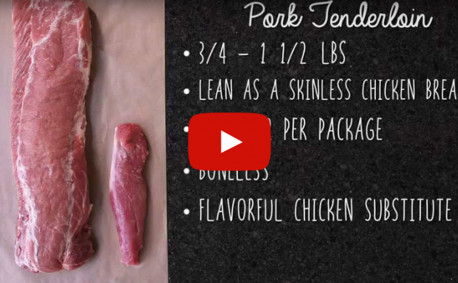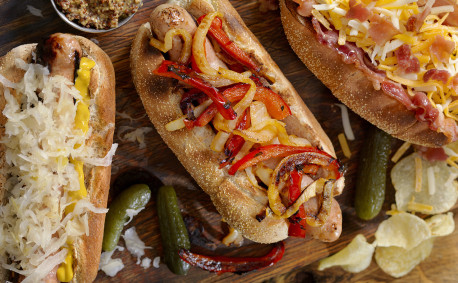Different Types of Sausage
We’re all familiar with the baron of the barbecue, a winner among wieners, his royal swine-ness: the hot dog. But how many of the seemingly endless variety of international sausages have you had the opportunity to try? If you’ve ever wanted to test your fervor for frankfurters or wondered what awaits you beyond the hot dog horizon, please enjoy this impressive list of international links!
The Wide World of Weenies: 8 Sausages from Around the Globe
Bratwurst
Brats are a classic, of course, but what you may not know is the first recipe for bratwurst was recorded in Nuremberg, Germany, in 1313 — over 700 years ago! The name bratwurst comes from the German words for “finely chopped meat” (brät) and “sausage” (Wurst). A Midwestern method for cooking the predominantly pork-based sausage — popularized in Wisconsin — involves simmering it in a mixture of beer, butter and onions before grilling.
Salami
Thought to have originated in Italy as early as the 1400s, this delightful deli meat became popular among European peasants because it could be stored at room temperature for months at a time. Made with pork or beef, the meat is fermented, cured, then air-dried. Pepperoni — a salami variety designed for the American palate — is seasoned with paprika (as well as red pepper-based seasonings) and cured with sodium nitrite, both of which are responsible for the spiced sausage’s signature red color.
Chorizo
Chorizo is originally from Spain and comes in dozens of different varieties across the world’s former Spanish colonies. The two kinds of chorizo you might be most familiar with are Spanish chorizo and Mexican chorizo. Both varieties are made from pork, but Spanish chorizo is flavored with paprika, garlic, herbs and wine and is fermented, smoked and air-cured, which yields a salami-like texture. Meanwhile, Mexican chorizo is flavored with chilis, vinegar, garlic and other spices but isn’t cured or smoked like its Spanish counterpart. Instead, Mexican chorizo is more often ground without a casing and fried in a skillet, making it a perfect filling for anything from traditional Mexican dishes to breakfast burritos.
Kielbasa
As the Polish word for sausage, kielbasa can refer to any variety of sausage found in Poland. But in the United States, kielbasa refers to a U-shaped sausage usually made of pork that is cured, ground, smoked and dried. The sausage is known for its versatility as an ingredient in Polish cuisine, making it a perfect addition to your summer cookout, a unique choice for your charcuterie board or a zesty ingredient in a hearty winter stew.
Andouille
This French-named, coarse-grained smoked sausage actually originated in Germany. Andouille became popular in the U.S. in the 1700s thanks to Black and French American culinary influence in Louisiana Cajun cuisine. Unlike traditional andouille, Cajun andouille is double-smoked — both before and after the meat is stuffed in its casing — and is predominantly flavored with salt and red pepper. With its spicy, smoky flavor, andouille remains a fundamental ingredient of Cajun dishes like jambalaya and gumbo.
Boerewors
Pronounced BOO-ruh-vors, this South African sausage is made of coarsely minced beef — sometimes mixed with pork, lamb or both — preserved with salt and vinegar, and flavored with spices like coriander and nutmeg. Traditional boerewors is best known for its continuous spiral shape. Like hot dogs in the U.S., boerewors are considered essential at any braai, the Afrikaans word for a South African cookout.
Longganisa
Despite having originated in Spain, the longganisa (longaniza in some Spanish-speaking locales) has become a source of intercultural reinvention. The spiced pork sausage was initially spread by Spanish colonialism and now exists in unique varieties in multiple regions of Spain, Argentina, Chile, the Dominican Republic, El Salvador, Guatemala, Mexico, Puerto Rico and the Philippines. The Filipino longganisa alone has multiple varieties, including the spicy longganisa de recado and the sweeter longganisa hamonado. Instead of being smoked or air-dried like other sausages, store-bought longganisas are pre-boiled then pan-fried when ready to serve.
Sai Oua
This spicy pork sausage is said to originate in Chiang Mai, Thailand, but some argue its origins can be traced further back to Laos or Burma. Although the minced pork is flavored by fragrant herbs and spices like lemongrass and turmeric, the defining flavor of sai oua (Sigh YOO-uh) comes from the Kaeung Kua red curry paste mixed in with the meat. Like boerewors, traditional sai oua is formed into a large, continuous spiral, making it stand out as a Thai street food.
More to Explore
This is only a sampling of your international sausage selection — we didn’t even have time to cover the Spanish butifarra, Japanese kurobuta sausage, Catalan fuet or the many varieties of blood sausage from around the world. But whether you’re a potential pork patron or a frankfurter aficionado, we guarantee more sausages are out there for you to explore!





